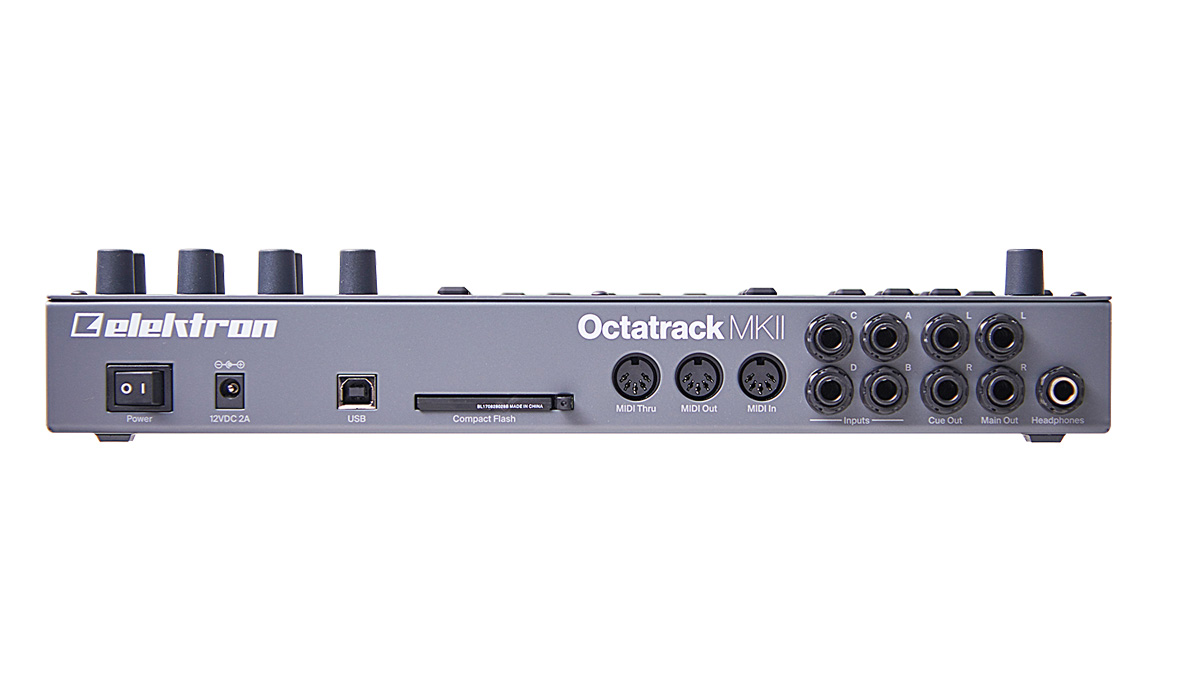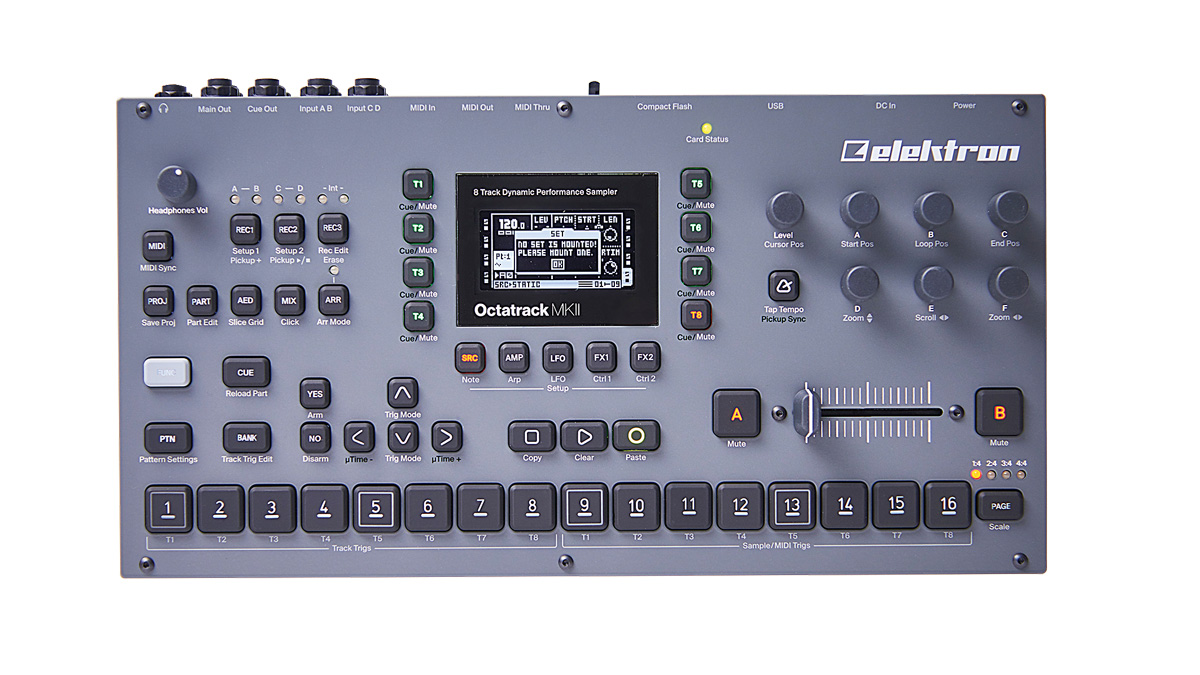MusicRadar Verdict
This update gives existing users little reason to upgrade and lacks DAW integration, but Octatrack remains the king of creative samplers.
Pros
- +
Additional buttons speed up workflow.
- +
New screen, buttons and rotaries improve on the original.
- +
Balanced inputs are a bonus.
Cons
- -
Lacks Overbridge compatibility or USB MIDI sync.
MusicRadar's got your back
When it was first released back in 2010, Elektron’s Octatrack didn’t have a lot in the way of competition in the pro-level, hardware sampler realm.
At the time, Akai’s MPC5000 was approaching the end of its lifecycle, soon to be replaced by the laptop reliant Renaissance, and NI’s relatively new Maschine system was proudly flying the flag for hands-on, software- powered sampling. Back then it might have seemed like the age of the hardware sampler was coming to an end.
Fast forward seven years though, and suddenly the Octatrack is less of an anomaly, with Akai’s MPC Live and X, and Pioneer DJ’s SP-16 and DJS-1000 all offering pro-spec’d standalone sampling.
Given this new wave of competitors, you might expect Elektron to have equipped this MkII iteration of the Octatrack with a raft of flashy new features. Actually, this new version is a subtly refined mechanical update rather than a significant reinvention; one which does little to break from the formula of the original.
In fact, in terms of actual features and capabilities, the only things added for the launch of the MkII arrived by way of an OS update that was also available to owners of the MkI. The only real tangible updates for the MkII are improvements to the hardware itself.
Some might bemoan this lack of significant enhancements, but in reality the Octatrack wasn’t particularly in need of a reinvention. Under the hood, this remains a remarkably powerful and well-equipped sampler, offering eight flexible audio channels, along with an eight-channel MIDI sequencer.
Admittedly, this leaves the Octatrack with fewer sample channels than some of its newbie competitors - both Pioneer samplers feature 16 channels, while the standalone MPCs can run considerably more channels, plus full audio recording - but for creative, on-the-fly manipulation of sounds, it remains pretty much unrivalled.

This flexibility comes via its multiple varieties of sample track ‘Machines’. Samples are handled by either Static or Flex Machines, both of which feature the same extensive processing options, but the latter loads samples into the Octatrack’s RAM for deeper on-the-fly manipulation.
Tracks can also play host to Neighbor Machines, which process audio coming from a neighbouring track, and Thru Machines, which allow the Octatrack to process external audio signals. Finally, Pickup Machines act as loopers, and are one of the Octatrack’s many great onboard tools for live performance.
Each track then processes its audio signal via a variety of sample/loop manipulation tools - including real-time pitchshifting, looping and timestretching - an envelope controlled amp and two effect slots, which can choose from a total of 14 processors. Each channel also packs three assignable LFOs, along with an LFO designer for detailed tweaking of the waveshape.
Playback of these Machines is controlled by the Octatrack’s deep, flexible sequencer. This is essentially a 64-step x0x-style button sequencer, but one that boasts a wealth of powerful tools that go well beyond simple on-off sample triggering.
The Octatrack uses a compact flash card slot to handle sample and project storage. It ships with a 16GB card but can accept cards up to 64GB. The supplied card comes stocked with 5GB of factory sounds provided by Loopmasters, Samples From Mars, Sample Magic and Origin. The unit itself packs just over 80MB of RAM for each project, used for Flex samples and the track recorder. By default, the Flex engine can be loaded with 64MB of samples, leaving the remaining RAM for the track recorders. You can change this balance to suit your workflow in the Octatrack’s settings menu.
For one thing, Elektron has equipped the Octatrack with its Parameter Lock automation system, which allows each sequencer step to save parameter settings for the bulk of the audio tracks’ processors. There are also multiple types of trigger offered by the sequencer, including swing timing triggers, triggers to initiate recordings, one-shot triggers and more.
Combined with micro-timing adjustments, retrigger capabilities and flexible scale and timing controls, the whole thing begins to feel like a very powerful tool.
The key new feature added alongside the launch of the MkII - but also usable on the original hardware - is the introduction of conditional triggers. These allow users to set a variety of rules governing if and when a sequencer trigger will occur.
A conditional trigger can be dependent on probability, on the triggers that preceded it, on whether or not the new Fill Mode is engaged, or even on what’s going on in a neighbouring sequencer channel. These are really excellent creative tools that make it easy to add variation and interest to sequencers. They’re great for livening up hats and toplines or creating experimental or evolving patterns.
There are a few more modern tricks that its closest rivals can do that are missing here, but no other hardware sampler can match the Octatrack for the sheer amount of creative depth it packs into its diminutive frame
The Octatrack’s crossfader is another handy tool for hands-on creativity. This allows users to morph between two Scenes, each containing a full range of saved parameter settings.
All of this is then contained within a deep overarching structure of patterns and projects that allows users to create multi-part arrangements, as well as structure full track sessions and live sets.
As mentioned, however, there are no new capabilities added exclusively to the Octatrack MkII, so all of the above is true of both the original and updated versions.
So what has changed for the MkII? Firstly, the interface’s push buttons have been replaced with the chunkier, backlit variety found on the Octatrack’s more affordable sibling Digitakt. Elektron says these are “rated for 50 million presses” - naturally, we haven’t been able to put this to the test in the course of this review, but the buttons do seem durable and feel nice under the fingers. They offer brighter, punchier backlighting too.
There are also more buttons overall, meaning fewer parameters are hidden behind ‘Function’ presses and menu dives. This is a big bonus - like many Elektron machines, the Octatrack has a deep and at-times baffling workflow, so anything that makes that slightly smoother and more intuitive gets a resounding thumbs up. The new interface now means that areas like project settings and the audio editor now get direct access from the front panel.
The screen has been given an overhaul too, with the MkII now coming equipped with the same OLED screen as the Digitakt. This is brighter and noticeably more crisp, which once again helps with workflow clarity.
Both the rotary encoders and the crossfader have been updated too. Elektron claims both are better quality and more responsive - personally we didn’t notice much difference from the previous hardware, but we have no complaints about either element.
Missed connection
One noticeable omission remains, however, in that this MkII Octatrack still lacks any sort of meaningful DAW integration. It does pack a back panel USB connection, but this is used solely for sample transfer and can’t be used for MIDI or audio interaction with a computer or wider studio setup.
This makes the Octatrack something of an anomaly amongst Elektron’s current hardware line-up. At the time of writing it’s its only recent product that can’t make use the brand’s excellent Overbridge software, which facilitates plugin-style control and parameter recall, along with audio-over-USB.
Speak to seasoned Octatrack users and many of them will tell you this isn’t much of a problem - the sampler is primarily designed as a hands-on performance instrument after all, so who wants to be controlling it using a laptop?
While it lacks digital audio or MIDI communication from the USB port, the Octatrack is otherwise well equipped on the I/O front. There are two pairs of balanced jack outputs, one set acting as the main outputs, one as a cue output. There’s also a separate back-panel headphone output. These are joined by four input packs, used for sampling, recording and processing audio, and arranged as two stereo pairs: A/B and C/D. For the MkII, these have been upgraded to balanced inputs, which is a nice touch, adding to the sampling and recording flexibility. These are joined on the rear panel by MIDI In, Out and Thru ports. The process of sampling and recording through the inputs - or internally resampling - is pretty smooth and intuitive, once you’ve got your head around the setup process. Recording can be done manually or triggered via the sequencer. Looping, via Pickup Machines, can also be controlled via a foot pedal. The inputs can be set up with noise gates and delay compensation. Once recorded, samples can be tweaked using the Octatrack’s flexible audio editor, which can be used to slice, trim and manipute recorded clips.
Personally though, we do think it’s a bit of a missed opportunity. For studio purposes, individual track outputs over USB would be a great option for getting your creations out of the sampler and into a DAW. A software edit interface would no doubt be a handy tool for preparing Octatrack projects for live performance too (although there is an unofficial application, OctaEdit, that helps with this to some extent).
Don’t go holding your breath waiting for this to arrive in a future update. Both iterations of the Octatrack are based on the same ‘brain’ and OS, which was originally developed before Overbridge ever existed. As Elektron confirmed when we reached out, this just isn’t technically equipped to handle Overbridge support.
Even taking this into account though, the Octatrack is still an excellent instrument. There are a few more modern tricks that its closest rivals can do that are missing here, but no other hardware sampler can match the Octatrack for the sheer amount of creative depth it packs into its diminutive frame.
It’s an absolutely fantastic live performance tool too, which could be adapted to work as the centrepiece of all sorts of different live or DJ setups. No wonder it regularly crops up on stage with some of the most interesting live performers in electronic music. Admittedly, with this depth comes a complex and often challenging workflow.
Even with the refined interface you should expect to spend a lot of time reading the manual and prepping settings if you really want to get the most out of the Octatrack. It does feel like it’s worth investing this time though, since the more you dig into this machine, the more you’re likely to discover.
All of this said, while the hardware is undoubtedly nicer-feeling, the balanced inputs are a bonus and the extra buttons make navigation easier, on the whole this MkII doesn’t give existing users much of a reason to upgrade. It remains a killer sampler, and comes highly recommended for new users, but if you’re currently in possession of a fully functioning MkI, there’s no need to rush out to the shops just yet.
I'm the Managing Editor of Music Technology at MusicRadar and former Editor-in-Chief of Future Music, Computer Music and Electronic Musician. I've been messing around with music tech in various forms for over two decades. I've also spent the last 10 years forgetting how to play guitar. Find me in the chillout room at raves complaining that it's past my bedtime.
“I used everything I knew about music”: How Green Day exceeded expectations with their most ambitious song
YouTube just added AI tools that makes musicians, library music and video editors redundant
“Every one of them said yes without hesitation": Hank Marvin and Roger Taylor have just remade a '60s classic for charity










